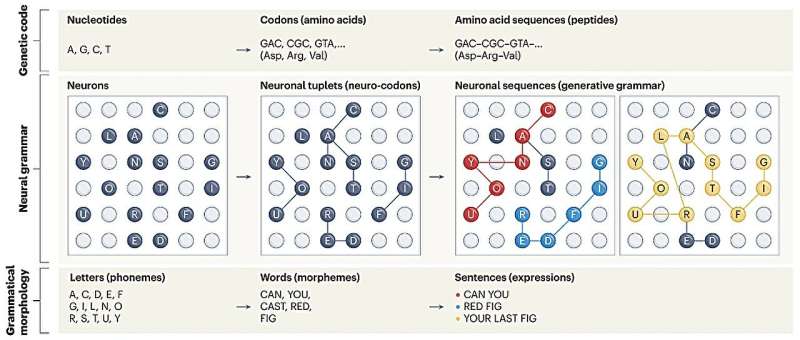This article has been reviewed according to Science X's editorial process and policies. Editors have highlighted the following attributes while ensuring the content's credibility:
fact-checked
peer-reviewed publication
trusted source
proofread
Re-frame of mind: Do our brains have a built-in sense of grammar?

For centuries, a prevailing theory in philosophy has asserted that at birth the human mind is a blank slate. More recently, the same notion has also held sway in the field of neurobiology, where it is commonly held that neural connections are slowly created from scratch with the accumulation of sensory information and experience.
Eventually, the theory goes, this allows us to create memories in space and time and to then learn from those experiences.
But after spending more than a decade studying activity in the hippocampus, the area of brain which forms memory, Yale's George Dragoi began to have his doubts.
In his research on the hippocampus of rodents, Dragoi, an associate professor of psychiatry and of neuroscience, has found that early in life there emerge in this part of the brain individual functional clusters of cells (and, soon after, short sequences of cells) that predictably will be activated by new experiences. Within days of birth, he found, these cells, clusters, and short sequences become the foundation for increasingly complex sequences of cell assemblies that allow for the creation of memories.
In a new article published in the journal Nature Reviews Neuroscience, Dragoi makes the case that the human brain also develops a cellular template soon after birth which defines who we are and how we perceive the world. He describes it as "the generative grammar" of the brain.
"Neurons organize like letters, then words, then sentences and paragraphs which allow for the internalization of the outside world," Dragoi said. "The brain has its own built-in sense of grammar."
The idea, he admits, runs counter to the tenets of empiricism, a centuries-old theory that all knowledge is derived from sensory experience. It also contradicts widely held assumption by life scientists that environmental stimuli will entirely dictate how the brain processes and stores information.
But there have been questions about the empiricist-driven theory for quite a while. One of the first holes in the theory, he notes, came not in the field of neurobiology, but in immunobiology. In that field, too, prevailing theory long held that the immune system is initially naïve to outside threats and develops specific responses only after being exposed to pathogens or other immunological threats. Beginning in the 1950s, however, research showed that humans are born with and spontaneously express pre-existing antibodies that respond to specific new pathogens.
In 2011, while he was a research scientist at MIT, Dragoi discovered that the hippocampus of adult mice and rats also possessed a preconfigured network of neurons that exist prior to exposure to specific outside stimuli, which are then activated over time as the rats are exposed to signals from the environment.
Eight years later, after he had come to Yale, Dragoi's group showed this preconfigured network actually emerges in three developmental stages during the third and fourth weeks of postnatal life, maturing at an age for rodents when infantile amnesia ends (analogous to what occurs in humans).
This network of cells, Dragoi says, is activated sequentially. To use the grammar analogy, even in the early days of life the rat's hippocampus possesses letters and short words, but not the ability to order them into meaningful sentences or paragraphs that can be stored as memories or to predict future changes in the environment.
This, he suggests, helps explain why humans also cannot recall experiences that occur in the first few years of life, a normal process called infantile amnesia. "They are constantly in the present," Dragoi said.
Later in life, however, these pre-existing cellular assemblies in the hippocampus activate a more sophisticated template, or grammar, that allows for the formation of memories that have pointers to specific places and time, Dragoi said.
Put another way, humans possess the neural competence to process external stimuli soon after birth, but only over time do we develop the ability to perform mental tasks and accurately perceive the world around us. This neural performance is enhanced over time, allowing us to draw on past experiences to infer the likelihood of future events, the hallmark of cognition and intelligence.
It's much like a runner who has the competence to run a 100-meter track course, but only at a slow pace. But with conditioning and training, the runner can run the same distance at increased speed and in different contexts.
Since his 2011 insight into the preconfigured network of neurons, Dragoi says, his Yale lab has begun to paint a fuller image of how the hippocampus and the rest of the brain use neural sequences as currency for internal representations about the external world.
"Recognition of this universal hierarchical neural grammar will help our understanding of principles and mechanisms underlying a cluster of higher order cognitive processes like memory, cognitive mapping, transitive inferences, and insight," he said.
More information: George Dragoi, The generative grammar of the brain: a critique of internally generated representations, Nature Reviews Neuroscience (2023). DOI: 10.1038/s41583-023-00763-0





















